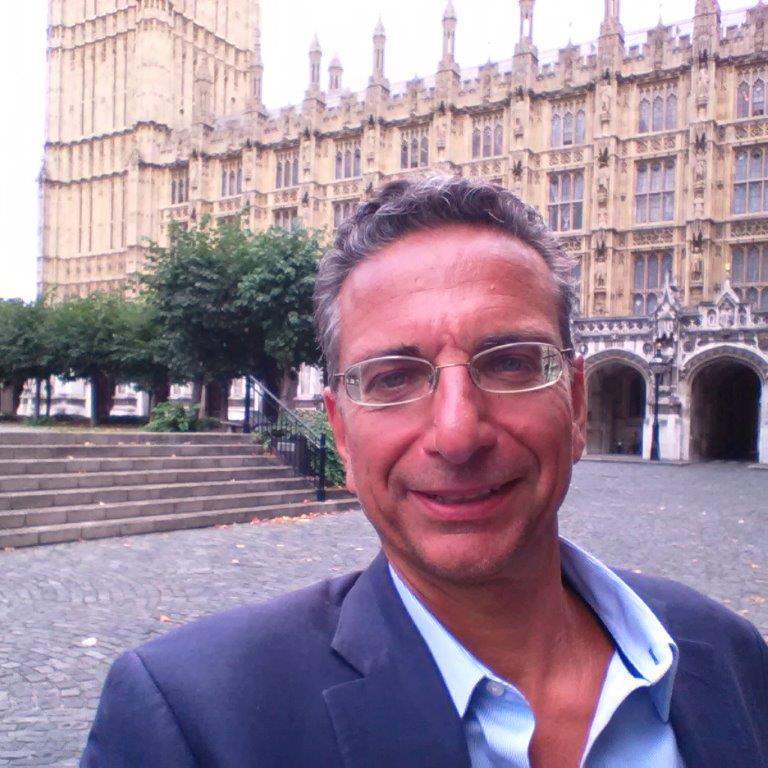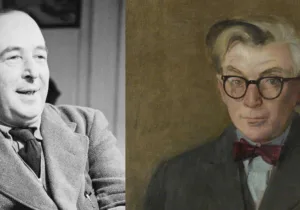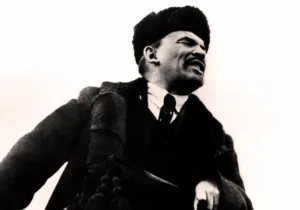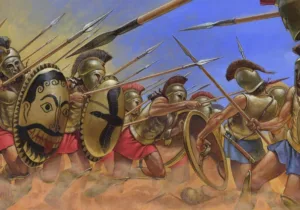Twenty-five years ago this Sunday, Mikhail Gorbachev resigned as General Secretary of the Soviet Union.Soon thereafter, the hammer and sickle would never been seen over the Kremlin again. It was a Christmas gift to the world, and to the Russian people most of all. In an early peak from the just-released fall issue, Providence senior editor Joseph Loconte reflects on the silver anniversary of the fall of the Soviet Union. For the magazine PDF click here, or simply continue below.
—
In one of the most prophetic speeches of the twentieth century, Ronald Reagan predicted the moral and political collapse of the mighty Soviet Union—a full decade before it occurred. At a time when the liberal establishment took the continued presence and influence of Soviet communism for granted, Reagan saw fatal internal weaknesses and contradictions. Addressing the British Parliament at Westminster Palace in June 1982, he explained:
We’re approaching the end of a bloody century plagued by a terrible political invention—totalitarianism. Optimism comes less easily today, not because democracy is less vigorous, but because democracy’s enemies have refined their instruments of repression. Yet optimism is in order, because day-by-day democracy is proving itself to be a not-at-all-fragile flower. From Stettin on the Baltic to Varna on the Black Sea, the regimes planted by totalitarianism have had more than 30 years to establish their legitimacy. But none—not one regime—has yet been able to risk free elections. Regimes planted by bayonets do not take root…It may not be easy to see; but I believe we live now at a turning point. In an ironic sense Karl Marx was right. We are witnessing today a great revolutionary crisis, a crisis where the demands of the economic order are conflicting directly with those of the political order. But the crisis is happening not in the free, non-Marxist West, but in the home of Marxist-Leninism, the Soviet Union. It is the Soviet Union that runs against the tide of history by denying human freedom and human dignity to its citizens.
Part of the genius of Reagan’s insight—ignored and disparaged by modern liberalism—was that regimes based upon the rejection of God and negation of human freedom would not endure. Respect for the natural rights and dignity of the individual, Reagan argued, was an essential foundation for a prosperous society. Reagan went on to lay out a strategy for promoting democratic reform around the globe, including the creation of the National Endowment for Democracy. He then delivered a line that would enrage the apparatchiks in the Kremlin: “What I am describing now is a plan and a hope for the long term—the march of freedom and democracy which will leave Marxism-Leninism on the ash-heap of history, as it has left other tyrannies which stifle the freedom and muzzle the self-expression of the people.”
Twenty-five years ago, Reagan’s vision was vindicated when the Soviet Union was officially dissolved in December 1991. Soviet leader Mikhail Gorbachev resigned as General Secretary on Christmas Day. Nearly beyond all hope or imagination, the forty-year-old Cold War between democratic capitalism and Soviet totalitarianism came to a peaceful end.
Almost no one saw it coming. Conventional liberal wisdom was that the United States and the Soviet Union had equally flawed political systems. They must work to “converge” and compromise for the sake of world peace. “Each superpower has economic troubles,” announced historian Arthur Schlesinger after a 1982 trip to Moscow. “Neither is on the ropes.” MIT economist Lester Thurow called it “a vulgar mistake to think that most people in Eastern Europe are miserable.” The intelligentsia concluded that Reagan’s prediction of Soviet decline was pure fantasy. Columbia University’s Seweryn Bialer insisted in 1982 that “the Soviet Union is not now nor will be during the next decade in the throes of a true system crisis, for it boasts enormous unused reserves of political and social stability that suffice to endure the deepest difficulties.”
After Reagan’s Westminster speech, historian Robert F. Byrnes collected essays from thirty-five experts on the Soviet Union—the cream of American academia—in a book titled After Brezhnev. Their conclusion: any thought of winning the Cold War was a pipe dream. “The Soviet Union is going to remain a stable state, with a very stable, conservative, immobile government,” Byrnes said in an interview. “We don’t see any collapse or weakening of the Soviet system.” As late as 1984, Harvard’s John Kenneth Galbraith echoed the mood of moral equivalency. “The Russian system succeeds because, in contrast to the Western industrial economies, it makes full use of its manpower.”
Well, now. Rarely in the field of human prognostication have so many self-appointed experts been so wrong about so much. It turns out that Ronald Reagan was not the naïve, warmongering ideologue of liberal imagination. Instead, the American president—who believed deeply in American exceptionalism—developed a coherent and plausible strategy to actually defeat the Soviet Union. Lou Cannon, the Washington Post reporter who covered the Reagan administration, later admitted: “the Westminster speech stands the test of time as the most farsighted and encompassing of Reagan’s anti-communist messages.”
Poland’s Solidarity Movement
What became known as the Reagan Doctrine effectively began in 1981, during the communist crackdown on the pro-democracy Solidarity movement in Poland. In December, Polish security forces invaded their own country: tanks rolled into Warsaw, roadblocks were set up, and the borders were sealed. Five thousand Solidarity members were rounded up in a single night. On December 13, the government declared martial law, driving the trade union underground.
The next day Reagan called Pope John Paul II, a native son of Poland, to seek ways they could cooperate to assist Solidarity. Reagan then told his staff at a National Security Council meeting: “We can’t let this revolution against Communism fail without our offering a hand. We may never have an opportunity like this in our lifetime.”
The White House authorized the CIA to finance protests, supply computers and fax machines to promote the democratic cause within Poland, and support television and radio broadcasts articulating the evils of Soviet domination. From 1981-88, the CIA spent about $50 million helping the trade union survive. Working with the Pope and British Prime Minister Margaret Thatcher, Reagan helped Solidarity to stay in touch with the West. The Pope met personally with Lech Walesa, the founder of Solidarity. In 1987, Thatcher became the first Western leader allowed to visit him. At a dinner with the communist leadership, Thatcher bluntly expressed her support for “freedom of expression, freedom of association and the right to form free and independent trade unions.”
Reagan also began funding insurgency groups combating communist dictatorships, from Latin America to the Near East. In Afghanistan, Reagan boosted support for the mujahadeen, the Islamic militants fighting the Soviet Army. The administration’s plan was to turn the Soviet invasion of Afghanistan into a Vietnam-style quagmire. It worked: The United States made the Soviets bleed in Afghanistan, and in 1989 the Soviet Army withdrew in defeat and disgrace.
The U.S. Military Build-Up
Although Moscow tried to conceal the truth from the West, the Reagan White House knew that the Soviet Union was in the throes of an economic crisis. Reagan adopted a defense strategy aimed not only at deterring Soviet aggression but also exploiting the economic weaknesses of the regime.
The pillars of Regan’s foreign policy toward the Soviet Union were established early in the administration, in its first major statement of Cold War strategy, National Security Decision Directive 75, approved in December 1982. The document describes two major objectives: first, to “contain and over time reverse Soviet expansionism. This will remain the primary focus of U.S. policy toward the USSR (italics added).” In other words, Reagan intended from the start to go beyond containment and to undo Soviet influence around the world. The second objective was “to promote…the process of change in the Soviet Union toward a more pluralistic political and economic system.” There was no liberal talk of “convergence” between the two rival systems, but rather the transformation of Soviet communism.
The Reagan Doctrine underwrote a massive military build-up—a five-year $1 trillion defense program—to convince the Russians they could never win a nuclear or conventional war against the United States. The White House also announced the Strategic Defense Initiative—dubbed “Star Wars”—a plan to use satellite technology to destroy nuclear missiles in flight. The idea was to outspend the Soviet Union in arms production to hasten its economic decline. As Reagan explained: “They [the Soviets] cannot vastly increase their military productivity because they’ve got their people on a starvation diet.”
All of these policies were controversial. But they placed immense pressures on the Soviet Union. “Someone in the Kremlin had to realize that in arming themselves to the teeth, they were aggravating the desperate economic problems in the Soviet Union,” Reagan wrote later, “which were the greatest evidence of the failure of Communism.”
Someone in the Kremlin did realize the dilemma—Mikhail Gorbachev. After becoming Soviet Premier in March 1985, Gorbachev at first reasserted the superiority of the communist system. “We are motivated by the ideas of the 1917 October Revolution,” he said, “the ideas of Lenin.” He bristled at Reagan’s critique of Soviet communism: “Those hoping to overstrain the Soviet Union” are “presumptuous,” he said. “So do not rush to toss us on the ‘ash heap of history.’ The idea only makes Soviet people smile.” Nevertheless, Gorbachev positioned himself as a reformer. His 254-page manifesto, called Perestroika (restructuring), promised to make the Soviet Union “richer,” “stronger,” and “better.” His programs of perestroika and glasnost (openness) were an attempt to rescue the Soviet economy from ruin.
1989: The Year of the Century
When Ronald Reagan turned over the presidency to George H.W. Bush in January 1989, the Soviet Union was on the brink of a geo-political freefall. But it didn’t look that way on the surface. At the start of the year, Moscow was firmly in control of its Eastern Bloc. In fact, two months before the 1988 presidential elections, the CIA excluded the possibility of any significant changes in the satellite states. “There is no reason to doubt ultimate Soviet willingness to employ armed force to maintain Party rule,” according to their report, “and preserve the Soviet position in the region.” Reagan dismissed the CIA’s skepticism.
Gorbachev’s policies of glasnost and perestroika, in fact, were emboldening populations fed up with the failures of the communist system: the empty shelves in the markets, the bread lines, the low wages, failing health system, and lack of basic freedoms. Gorbachev thought he could reform the Soviet system, liberalize it, and revive the entire communist project in the Soviet Union. It was a fool’s errand.
Beginning in 1989, opposition movements were gaining ground in virtually all of the Soviet Bloc states. Poland—the nation that first drew the democratic support of Reagan, Thatcher, and the Pope—lit the match that set off the revolutions of 1989. The Polish government, in the hands of beleaguered communist bureaucrats, agreed to hold free elections in June. Ninety-nine out of 100 seats in the legislature were won by Solidarity candidates.
Would Moscow allow the election results to stand?
Gorbachev called the head of the Polish Communist Party and said the Soviet Union would accept the outcome of the election. Lech Walesa was elected president, giving the country a democratic leader and a government with a communist minority: The communists in Poland surrendered power. The Brezhnev Doctrine—the principle that no state that had become communist could leave the Soviet fold—was effectively dead. Gorbachev’s phone call may have been the call that ended the Cold War.
Next came Hungary. In October, on the anniversary of the 1956 democratic uprising, Hungary abolished its communist party, declared itself a multi-party republic, and opened its borders. In November, it was East Germany’s turn: Watching these events at home, East Germans started pouring through Hungary into West Germany, destabilizing the East German government. Meanwhile, mass marches and demonstrations were held throughout cities such as Berlin and Leipzig. The German communist leadership asked Moscow to send in troops and tanks. Gorbachev told them to either enact reforms or get out of the country. The government opened the borders, and soon the Berlin Wall—the wretched symbol of totalitarian control—crumbled. Within weeks, demonstrations in Czechoslovakia led to a general strike and a parliamentary election that anointed a dissident poet, Václav Havel, as prime minister. It was called the Velvet Revolution.
It seemed unimaginable: peaceful democratic revolutions succeeded in virtually the entire Eastern Bloc, making 1989 the year of the century.
The Disintegration of the Soviet Union
The atmosphere of freedom soon enveloped the Soviet Union itself. Economic stagnation spurred independence movements in the Baltic states of Estonia, Lithuania, and Latvia. By March 1990, they all broke from Moscow. Meanwhile, democratic reformer Boris Yeltsin was elected president of Russia and promptly resigned from the Soviet Communist Party.
All of this was too much for Kremlin hardliners. On August 18, 1991, they placed Gorbachev under house arrest and staged a coup. Yeltsin climbed on top of a tank outside the parliament building and rallied anti-coup demonstrators in Moscow. The coup plotters, incompetent and shaken by the crowds, backed down. Gorbachev was restored to power, but his days were numbered—and so were those of the Soviet Union.
“Some people have urged the United States to choose between supporting President Gorbachev and supporting independence-minded leaders throughout the U.S.S.R.,” President Bush told an audience in Ukraine. “I consider this a false choice. In fairness, President Gorbachev has achieved astonishing things, and his policies of glasnost, perestroika, and democratization point toward the goals of freedom, democracy, and economic liberty.”
This was Bush-style diplo-speak: Gorbachev’s policies were supposed to revive and strengthen the Soviet Union—not inaugurate democratic capitalism or hasten the dissolution of the empire. Between August and December, ten republics declared their independence from Moscow. On December 1, in a popular referendum in Ukraine, ninety percent of voters chose independence. The exit of Ukraine—the second-most powerful republic—meant the end of any hope of preserving even a shrunken version of the Soviet Union. A week later, Russia, Ukraine, and Belarus formed a loose Confederation of Independent States.
On Christmas Day, December 25, 1991, Gorbachev resigned as General Secretary, and the Soviet flag flew over the Kremlin in Moscow for the last time. “This society has acquired freedom. It has been freed politically and spiritually, and this is the most important achievement that we have yet fully come to grips with,” Gorbachev said in a televised address. “And we haven’t, because we haven’t learned to use freedom yet.” History suggests that the desire for freedom is not enough—not when the state holds all the guns and runs the secret police. A political opening is required. By allowing Eastern Europe to go its own way, Gorbachev provided the opportunity.
The next day, the Supreme Soviet formally declared that the Soviet Union had ceased to exist as a functioning state. And what of its legacy? Over its seventy-year lifespan, roughly twenty-five million people are believed to have perished because of its violent experiment in Marxism-Leninism. No ideology had set out with such ruthlessness to destroy the Judeo-Christian heritage of Europe. No regime in history had amassed such a catalogue of human suffering: the purges, show trials, man-made famines, the gulags, ethnic cleansings, mass executions, and the culture of terror and paranoia. And when the awful, tortuous, and tragic story finally ended, no one—at least none of its victims—mourned its passing.
The Triumph of the Reagan Doctrine
Who gets credit for ending the Cold War? Liberals usually attribute the fall of the Soviet Union to its “structural weaknesses.” Strobe Talbott, a former Clinton administration official and now president of the Brookings Institution, has argued that the Soviet Union collapsed on its own accord because of its economic problems. “The Soviet system has gone into meltdown because of inadequacies and defects at its core,” Talbott wrote, “not because of anything the outside world has done or not done…The doves in the great debate of the past 40 years were right all along.”
It is hard to imagine a more impoverished political judgment: a thoroughly secular, materialistic view of the human person. The American Left ignores the fact that the people of Eastern Europe—people from all walks of life—never abandoned their hopes for political and spiritual freedom. With leaders such as Margaret Thatcher, Pope John Paul II, and Ronald Reagan supporting them, they persevered in their struggle for human dignity. Their moral courage helped to bring the Soviet leadership to its knees.
Equally important, four decades of patient containment by the democratic NATO alliance took its toll on the Soviet system. The Reagan Doctrine—the projection of U.S. military power to defeat communism—finally brought the crises of the Soviet Union to a boiling point. And what of Gorbachev’s role? We should first ask why a reformer of his kind rose to power in the Kremlin in the first place—and during Reagan’s presidency. Ilya Zaslasky, a member of the democratically elected Russian parliament, provided an answer: “Ronald Reagan was the father of perestroika.” Poland’s Lech Walesa agreed: “I wonder whether today’s Poland, Europe and world could look the same without President Reagan. As a participant in those events, I must say that it’s inconceivable.”
Against his critics, Reagan employed tough diplomacy, with moral clarity and spiritual insight, to challenge Soviet communism. It is easy to forget how deeply unpopular Reagan’s views were throughout the 1980s. His rhetoric about the Soviet Union as “an evil empire” sent leftist elites into apoplexy. The New Republic denounced his “primitive prose and apocalyptic symbolism.” Princeton University’s Stephen Cohen dismissed Reagan’s policies as “a pathological rather than a healthy response to the Soviet Union.”
If there was a pathology involved in America’s confrontation with Soviet communism, it was the sickness of mind that could not distinguish between the flawed democracy of the United States and the totalitarian horror of the Soviet Union. This pathology, this debased mental outlook about America’s influence in the world, is alive and well in modern liberalism. Its pre-eminence during the Age of Obama has allowed new forms of terror to thrive. “If history teaches anything,” Reagan warned, “it teaches that self-delusion in the face of unpleasant facts is folly.”
It will take a new generation of leaders, in the pattern of Ronald Reagan, to lift the fog of delusion and folly in our own day.
—
Joseph Loconte is an associate professor of history at the King’s College in New York City and a senior editor at Providence. His most recent book is the New York Times bestseller A Hobbit, a Wardrobe, & a Great War: How J.R.R. Tolkien & C.S. Lewis Rediscovered Faith, Friendship, & Heroism in the Cataclysm of 1914-1918.
Image: Reagan at the Brandenburg Gate, June 1987–wikimedia commons







 Sponsor a student for Christianity & National Security 2024
Sponsor a student for Christianity & National Security 2024